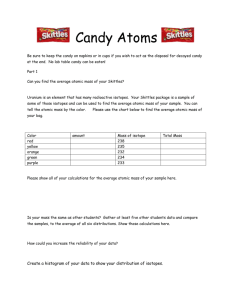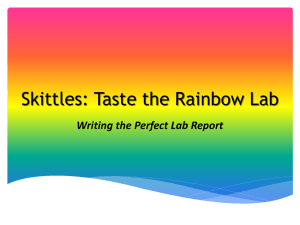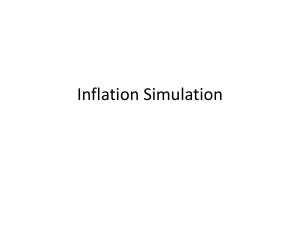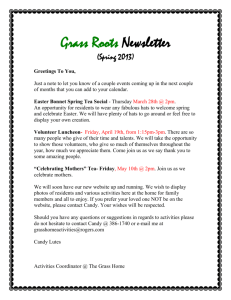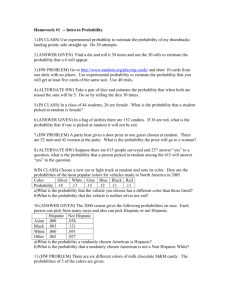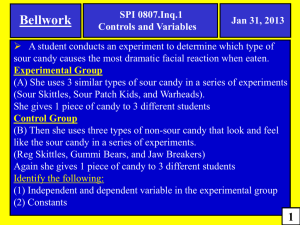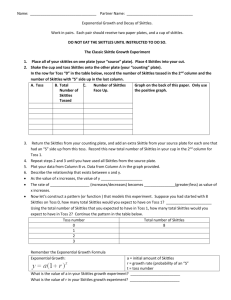Conditional Probability Worksheet: M&Ms & Skittles
advertisement
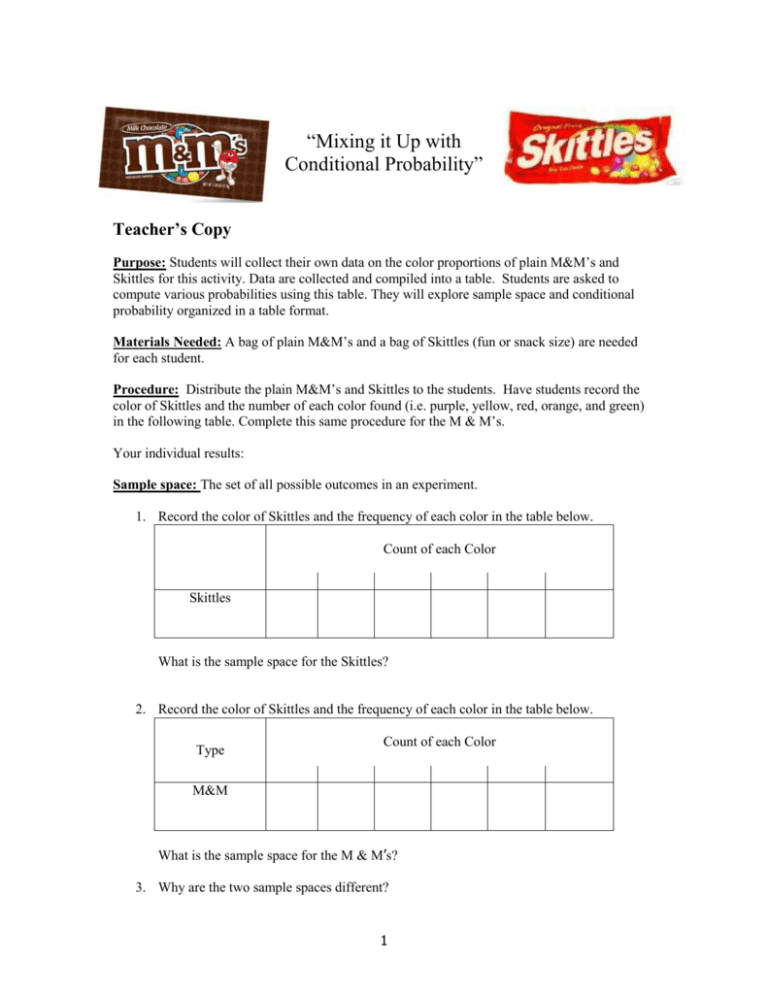
“Mixing it Up with Conditional Probability” Teacher’s Copy Purpose: Students will collect their own data on the color proportions of plain M&M’s and Skittles for this activity. Data are collected and compiled into a table. Students are asked to compute various probabilities using this table. They will explore sample space and conditional probability organized in a table format. Materials Needed: A bag of plain M&M’s and a bag of Skittles (fun or snack size) are needed for each student. Procedure: Distribute the plain M&M’s and Skittles to the students. Have students record the color of Skittles and the number of each color found (i.e. purple, yellow, red, orange, and green) in the following table. Complete this same procedure for the M & M’s. Your individual results: Sample space: The set of all possible outcomes in an experiment. 1. Record the color of Skittles and the frequency of each color in the table below. Count of each Color Skittles What is the sample space for the Skittles? 2. Record the color of Skittles and the frequency of each color in the table below. Type Count of each Color M&M What is the sample space for the M & M’s? 3. Why are the two sample spaces different? 1 4. Considering the tables from before: a. Are all of the colors equally likely for the Skittles? b. Are all of the colors equally likely for the M&M’s? 5. Since the total number of Skittles and M &M’s are different, how does this affect the probability? 6. If we randomly select a piece of candy and consider only the Skittles, which color has the greatest probability? 7. If we randomly select a piece of candy and consider only the M&M’s, which color has the greatest probability? Compile your group results in the table below: Type Color Totals Skittles M&M’s Totals Using the group results from the table above: 8. What is the probability of randomly picking an orange piece of candy? 9. What is the probability of randomly picking a brown M & M? What is the probability of randomly picking a brown piece of candy? How do these probabilities connect to the sample spaces of the two types of candy? 10. What is the probability of randomly picking a Skittle and a red piece of candy? 11. What is the probability of randomly picking a Skittle or a red piece of candy? 12. Explain why #10 and #11 do not result in the same probability. 2 Sometimes we might be interested in considering only some of the candy in calculating our probabilities. We call this conditional probability. For example, we might like the color green and want to find the probability of randomly picking it for a certain type of candy. 13. Considering only the green pieces of candy, what is the probability of randomly picking a Skittle? 14. Considering only the Skittles, what is the probability of randomly picking a green piece of candy? Should this probability be the same as in #13? Explain. Another way to think about conditional probability is that you are “given” certain information and then told to calculate the probability. 15. Given that the candy was red, what is the probability that it was an M&M? 16. Find the probability of randomly choosing an M & M given that the candy was yellow. 17. Given that the candy was brown, what is the probability that it was an M&M? Compile the class results in the table below: Type Color Skittles M&M’s Totals Go back and recalculate the probabilities for #’s 13-17. Are the results the same? Explain. 3 Totals 18. The following table lists the number of students that participated in certain track events. Gender Track Event Jumping Running Throwing Other Total Male 15 56 20 34 125 Female 11 35 4 16 66 Total 26 91 24 50 191 a. What is the probability that a randomly selected student participated in a jumping event? b. What is the probability that a randomly student was male and participated in a running event? c. Considering only females, what is the probability that a student participated in a throwing event? d. What is the probability that a randomly selected student participated in a throwing event, given that he was male? e. Compare the probabilities in parts c and d. What is learned about throwing events when investigating these probabilities? f. Based on the fact that there were 15 males and only 11 females in jumping events, would it be correct to say that “Males prefer jumping events more than females”? Why or why not? 4 Most of the time, you will not use data that you collected, but rather information will be presented in text and you will need to create a table. In the following two problems, create your own table and then answer the questions. 18. There are 40 employees in a certain firm. 28 of these employees are males, 2 of these males are secretaries and 10 secretaries are employed by the firm. a. What is the probability that an employee chosen at random is a secretary, given that the person is a female? b. What is the probability that an employee chosen at random is a secretary, given that the person is a male? c. Would it be fair to say that this firm is gender biased? Explain your reasoning. 5 19. At a certain hospital, 40 patients have lung cancer, 30 patients smoke, and 25 have lung cancer and smoke. Suppose the hospital contains 200 patients. a. If a patient chosen at random is known to smoke, what is the probability that the patient has lung cancer? b. Given that a person has lung cancer, what is the probability that he or she smoked? c. Which conditional probabilities would we utilize to prove or disprove the statement, “Smokers have a higher rate of lung cancer”? Explain your reasoning. 6
